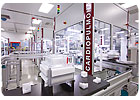
With the Montrac transport system and its self-propelled shuttles, different production and logistical operations can be linked.

Each Montrac shuttle is equipped with sensors to avoid collision with other shuttles or possible hindrances.
“When we introduced the new range of oxygenators, we decided to adapt our production technology accordingly,” says Andreas Gröbe, manager of Maquet’s assembly plant in Hechingen, Germany.
The company’s plant consisted of several flexible production islands. To reduce cycle time and increase capacity utilization, Maquet needed a way to transport assemblies from one island to the next in a way that was not necessarily linear. “The idea was to install an advanced and innovative transport system to link all the assembly stations,” says Gröbe. “In this respect, the key benefit is that the rails are very easy to clean.”
One factor was critical for Maquet’s production engineers when choosing a transport system: It had to be compliant with clean room requirements (Class 10,000 to 100,000). The Montrac transport system met that requirement. Montrac consists of an extruded aluminum monorail and a variable number of shuttles that can carry 30-kilogram loads.
Maquet chose Montrac “because the generation of particles due to friction is minimal compared to conventional systems using belt conveyors,” explains Gröbe.
After installing two monorail tracks, Maquet’s engineers measured free particles in the atmosphere and found that the system easily met clean room requirements.
Maquet’s engineers also liked Montrac’s modular system of rails, crossings and switches. “The transport line had to be integrated in the existing clean rooms without modifications or expansions,” says Gröbe. “Besides leveraging [our limited] available space, we also wanted...flexibility for subsequent modifications or adjustments in case of new product introductions.”
In fact, the original Montrac lines have already been modified twice, and “everything went smoothly.” Today, two Montrac systems are up and running in Hechingen: a 55-meter track with 17 shuttles, and a 9-meter track with nine shuttles. All shuttles travel at speeds up to 30 meters per minute.
“Another factor for the selection of Montrac was its easy integration with the existing assembly stations, especially the positioning units,” adds Gröbe. “In case of failure, we only have to remove a defective shuttle, and the plant keeps working.”
Maquet employees quickly became confident with the shuttles. The shuttles are controlled by Intelligent Routing Modules and Intelligent Shuttle Modules, which exchange information through an optoelectronic channel in the infrared range.
During commissioning, a problem arose: The control modules were found to be sensitive to electrostatic discharge. As a result, shuttle coding was sometimes lost. The problem was solved by grounding the rails electrically and adjusting the programming.
Overall, Maquet is very satisfied with the transport system. Indeed, the company is planning to install Montech’s ErgoTrac tilting units to improve ergonomics of the manual workstations.
For more information on monorail transport systems, call 888-627-8383 or visit www.maquet.com.